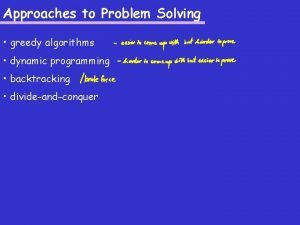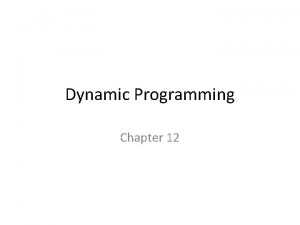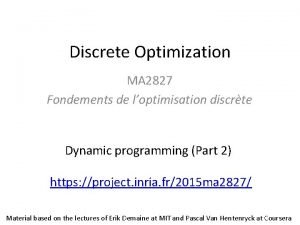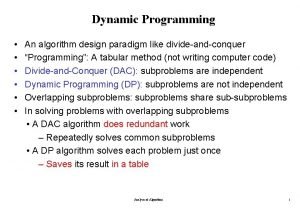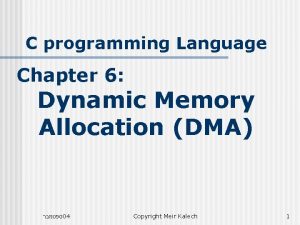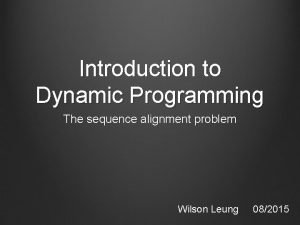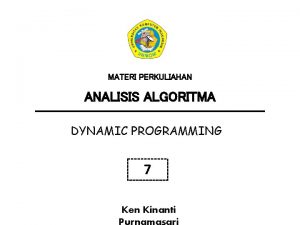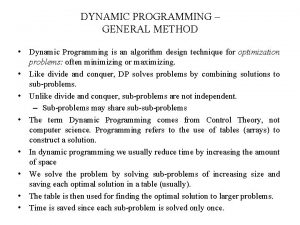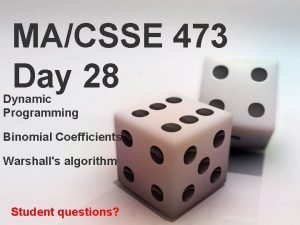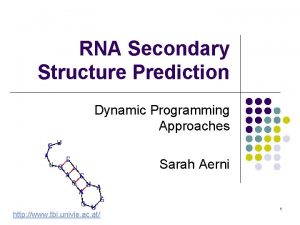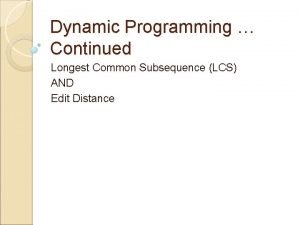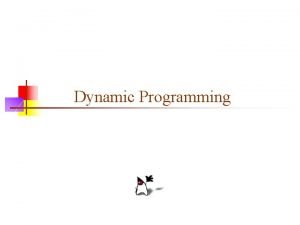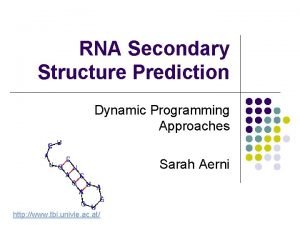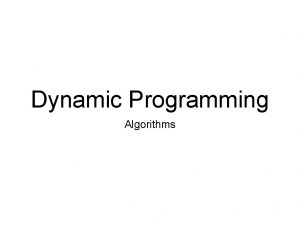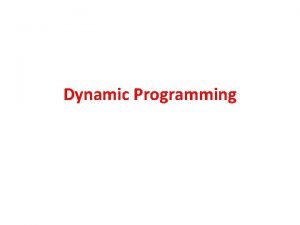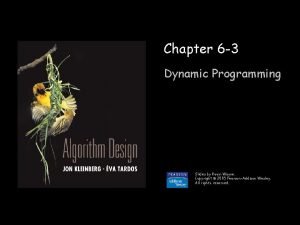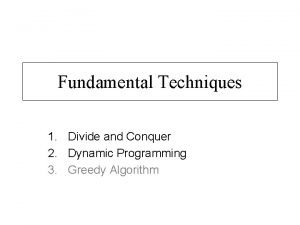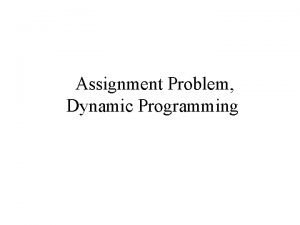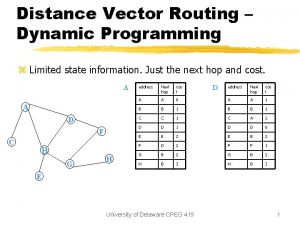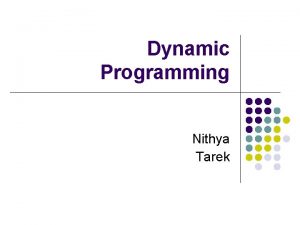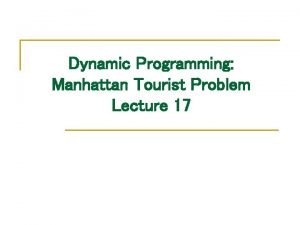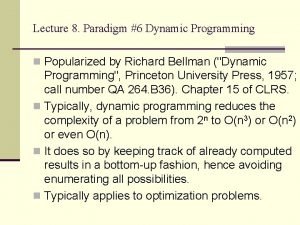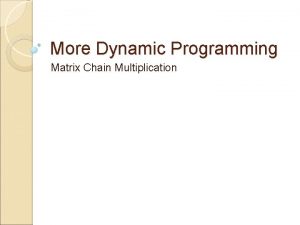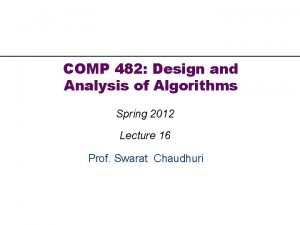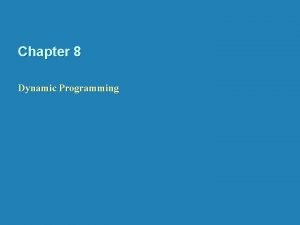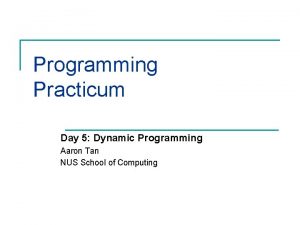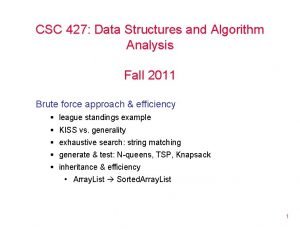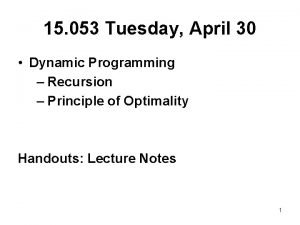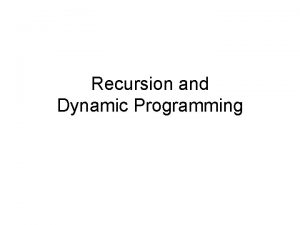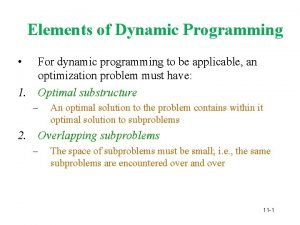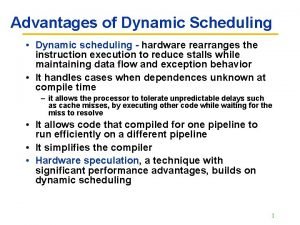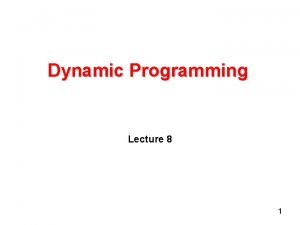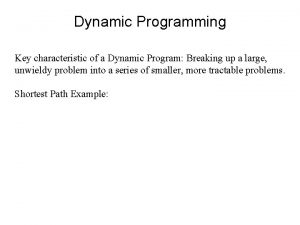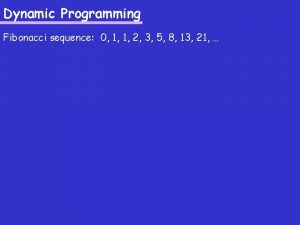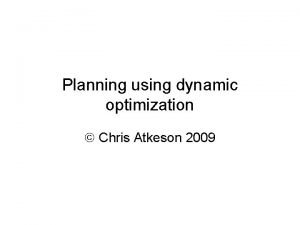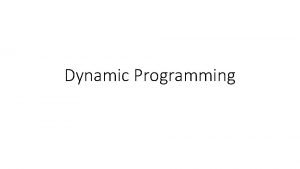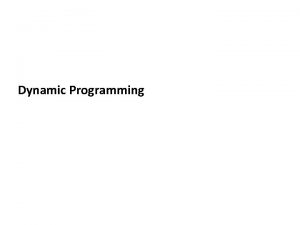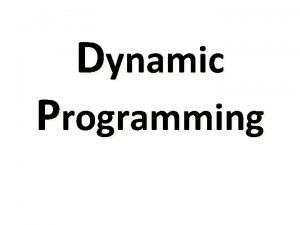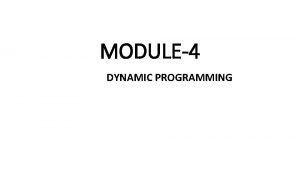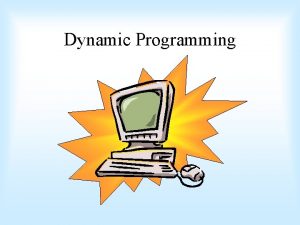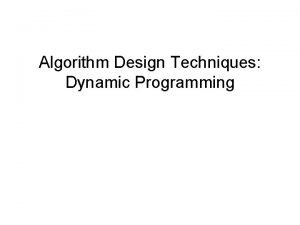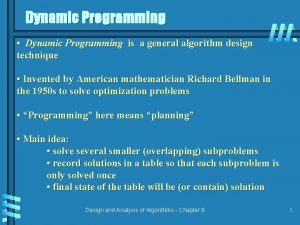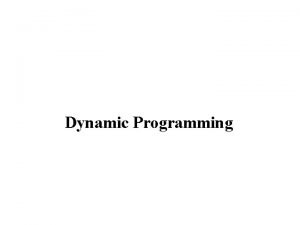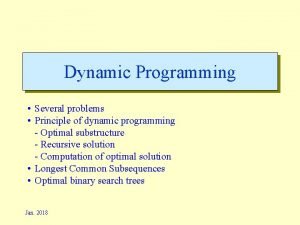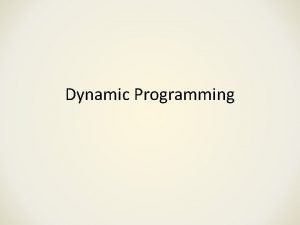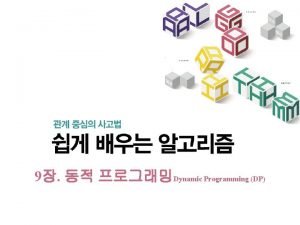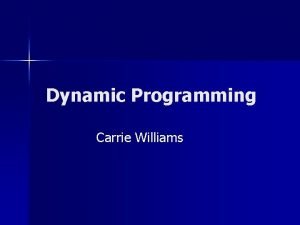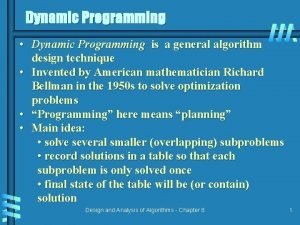Dynamic Programming Chris Atkeson 2012 Dynamic Programming x











































- Slides: 43

Dynamic Programming Chris Atkeson 2012

Dynamic Programming • • x: continuous state u: continuous control or action Discrete time dynamics: xk+1 = f(xk, uk) Cost function: L(x, u) Value function V(x) = ∑L(x, u) Q function Q(x, u) = L(x, u) + V(f(x, u)) Bellman Equation V(x) = minu Q(x, u) Policy/control law: u(x) = argminu Q(x, u)

Value Function

Policy

Why Dynamic Programming? • Trajectory optimization (including receding horizon control) can produce high quality answers. • However, trajectory optimization often gets stuck in local minima that are not useful. • We combine dynamic programming and trajectory optimization to get high quality answers with fewer problems from local minima. DP produces an initial trajectory, which is refined by optimization. • DP produces a policy u(x)

Why Dynamic Programming? • Policy optimization can produce useful answers. • However, need to choose good features/basis functions/parameterization.

The Curse of Dimensionality • Continuous States: Storage cost: resolutiondx State computational cost: resolutiondx • Continuous Actions: Action computational cost: resolutiondu

How to do Dynamic Programming (specified end time T) • • Dynamics: xk+1 = f(xk, uk) Cost: C() = c. T(x. T) + c(xk, uk) Value function Vk(x) is represented by table. VT(x) = c. T(x) For each x, Vk(x) = minu(c(x, u) + Vk+1(f(x, u))) This is the Bellman Equation This version of DP is value iteration Can also tabulate policy: u = k(x)

How to do Dynamic Programming (no specified end time) Cost: C() = c(xk, uk) VN(x) = a guess, or all zeros. Apply the Bellman equation. V(x) is given by Vk(x) when V stops changing. Goal needs to have zero cost, or need to discount so V() does not grow to infinity: • Vk(x) = minu(c(x, u) + Vk+1(f(x, u))), < 1 • • •

Policy Iteration • u = (x): general policy (a table in discrete state case). • *) Compute V (x): V k(x) = c(x, (x)) + V k+1(f(x, (x))) • Update policy (x) = argminu(c(x, u) + V (f(x, u))) • Goto *)

Stochastic Dynamic Programming • Cost: C() = E(c(xk, uk)) • The Bellman equation now involves expectations: • Vk(x) = minu. E(c(x, u) + Vk+1(f(x, u))) = minu(c(x, u) + p(xk+1)Vk+1(xk+1)) • Modified Bellman equation applies to value and policy iteration. • May need to add discount factor.

Continuous State DP • Time is still discrete. • How do we discretize the states?

How to handle continuous states. • Discretize states on a grid. • At each point (x 0), generate trajectory segment of length N by minimizing C(u) = c(xk, uk) + V(x. N) • V(x. N): interpolate using surrounding V() • Typically multilinear interpolation used. • N typically determined by when V(x. N) independent of V(x 0) • Use favorite continuous function optimizer to search for best u when minimizing C(u) • Update V() at that cell.

State Increment Dynamic Programming (Larson) c 1 V(x 0) c 0 c 2 V(x. N)

State Increment Dynamic Programming

Discretizations • Grid, multilinear interpolation

Adaptive Grids • Ideal grid: local optimizer gets right answer in each cell. – Split at policy discontinuities. – Split to avoid local optima. • Challenge: can you figure out good tessellation without fully solving problem?

Munos and Moore, Variable Resolution Discretization in Optimal Control Machine Learning, 49 (2/3), 291 -323, 2002

Kuhn Triangulation, kd-trie

Kuhn Triangulation in 3 D

Trajectory Segments

Mountain Car

Value Function

Value Function

Discretizations

Where Split? • Violations of V(x) of cell/region from model (constant, linear, quadratic, …) • Violations of u(x) of cell/region from model (constant, linear, …) • Some criteria applied to predecessors (how much change in V needed to affect trajectory? )

Policy Iteration: Continuous State • • • Discretize states Represent policy at discretized states u(x) Each cell in table has constant u, or u as knot points for linear or higher order spline *) Same kind of trajectory segments used to compute V k(x) = c(x, (x)) + V k+1(x. N) • Optimize policy (x) = argminu(c(x, u) + V (f(x, u))) using favorite continuous function optimizer. • Goto *)

Stochastic DP: Continous State • Cost: C() = E(c(xk, uk)) • Do Monte Carlo sampling of process noise for each trajectory segment (many trajectory segments), or • Propagate analytic distribution (see Kalman filter) • The Bellman equation involves expectations: • Vk(x) = minu. E(c(x, u) + Vk+1(f(x, u)))

Insight • Try to develop planning methods that scale computational cost according to complexity of problem. • Simple problems are easy to solve (LQR) • Complicated problems are expensive to solve, or aren’t solvable with current methods.

Ideas • • • Randomly sample actions Randomly sample states Use local models Propagate local models along trajectories Locally optimize Coordinate local optimizations to globally optimize.

What about continuous actions?

Randomized Dynamic Planning? • Probabilistic Roadmaps (aka PRM) • Rapidly Exploring Random Trees (RRT)

Random Sampling DP: Related Work • Semi-uniform strategies in multi-armed bandit problems: Epsilon-X strategies. • Evolutionary (random) action search. • Nemirovsky and Yudin: can’t beat curse of dimensionality in continuous action search. • Rust 97: Random sampling of states in stochastic DP. E() smooths problem. Beat curse of dimensionality for computing E(). • Thrun 00: POMDPs. Random sampling of belief states. Nearest neighbor interpolation of V(). Coverage vs. surprise test.

Random Action Search • Time invariant deterministic problem: find steady state solution. • Continuous actions. • Q function: Q(x, u) = L(x, u) + V(f(x, u)) • Bellman’s equation: V(x) = minu Q(x, u) • Try current policy u(x): Q(x, u(x)) • Try 1 random action urandom: Q(x, urandom) • Take best one: ubest : Q(x, u(x)) < Q(x, urandom)? • Update V(x) = Q(x, ubest), u(x) = ubest

DP Asynchronous

Two Link Swing Up • • • State: Action: Cost function: State Resolution: 100 x 100 million states

Two Link Swing Up

Two Link Swing Up

Angle Angular Velocity Two Link Swing Up Torque

Effects of Action Grid Size Two Link: 60 x 60 x 60

Repeatability (8 -1004, 1 -1484)

Search More Actions Per Update?

Random Sampling of Actions: Improvements • Tune distribution to problem. • Do some local optimization (gradient descent): so far only slows search down. • Smooth output trajectory with trajectory optimization. • Schedule updates adaptively
 Chris atkeson
Chris atkeson Greedy vs dynamic
Greedy vs dynamic Transferered
Transferered Dynamic programming
Dynamic programming Dynamic programming excel
Dynamic programming excel Egg drop dynamic programming
Egg drop dynamic programming Discrte
Discrte Algorithm design paradigm
Algorithm design paradigm Steps of dynamic programming
Steps of dynamic programming Dynamic c programming
Dynamic c programming Gap strategy in dynamic programming
Gap strategy in dynamic programming Contoh algoritma dynamic programming
Contoh algoritma dynamic programming Dynamic programming general method
Dynamic programming general method Binomial coefficient using dynamic programming
Binomial coefficient using dynamic programming Rna secondary structure dynamic programming
Rna secondary structure dynamic programming Tabulation dynamic programming
Tabulation dynamic programming Knapsack dynamic programming
Knapsack dynamic programming Longest common substring recursive
Longest common substring recursive Dynamic programing
Dynamic programing Pseudoknot structure
Pseudoknot structure Levenshtein distance for oslo-snow
Levenshtein distance for oslo-snow Greedy divide and conquer dynamic programming
Greedy divide and conquer dynamic programming Dynamic programming slides
Dynamic programming slides Advantage of dynamic memory allocation
Advantage of dynamic memory allocation Divide and conquer
Divide and conquer Assignment problem dynamic programming
Assignment problem dynamic programming Dynamic programming
Dynamic programming Dynamic programming
Dynamic programming Dynamic programming excel
Dynamic programming excel Dynamic programming
Dynamic programming Dynamic programming paradigm
Dynamic programming paradigm Matrix chain multiplication
Matrix chain multiplication Segmented least squares dynamic programming
Segmented least squares dynamic programming Robot coin collection dynamic programming
Robot coin collection dynamic programming Dynamic programming
Dynamic programming Dynamic programming
Dynamic programming Dynamic programming recursion example
Dynamic programming recursion example Recursion vs dynamic programming
Recursion vs dynamic programming Gerrymandering dynamic programming
Gerrymandering dynamic programming Dynamic programming algorithm
Dynamic programming algorithm Advantages of dynamic programming
Advantages of dynamic programming Dynamic programming history
Dynamic programming history Characteristics of dynamic programming
Characteristics of dynamic programming Fibonacci sequence dynamic programming
Fibonacci sequence dynamic programming



